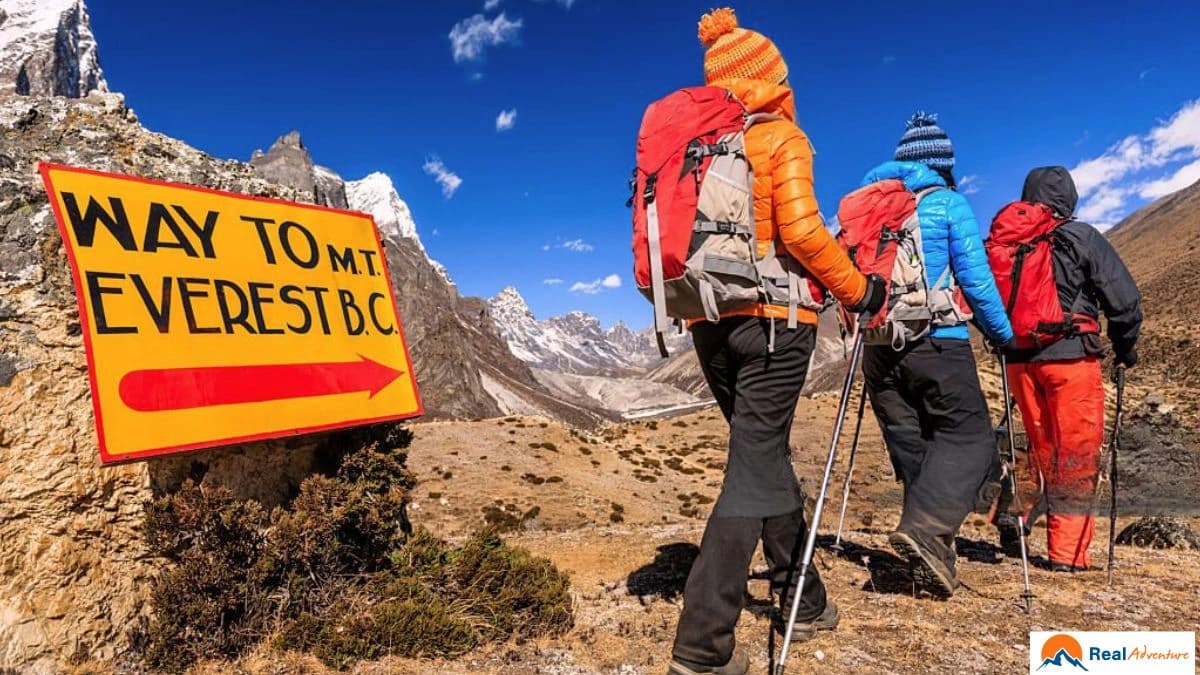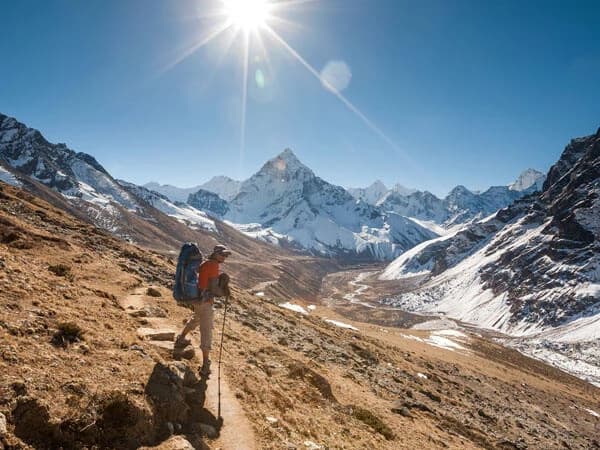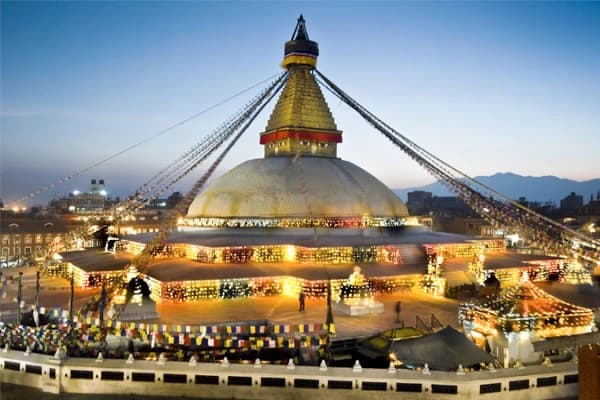Everest Base Camp is on many people's bucket lists. Many people or tourists dream of climbing the highest peak in the world, Mount Everest, located at a height of 5,364 meters (17,598 feet). It is an iconic mountain known for its stunning views of Lhotse, Nuptse, and Ama Dablam.
The journey to Everest Region passes through snow-peaked mountains, bridges, rivers, dense forests, and waterfalls. The steep and rugged trail requires lots of climbing and descending, which makes it difficult. So, how hard is Everest Base Camp trek? This blog will guide you through the difficulty of the Everest Base Camp trek.
Overview of Everest Base Camp
Everest Base Camp is a popular trekking destination in Nepal's Khumbu region. It serves as the base camp for climbers attempting to reach the summit of Mount Everest. The trek features stunning landscapes, demanding trails, and a rich cultural experience surrounded by the world's highest mountains. It's a journey that will inspire you with its natural beauty and the unique lifestyle of the Sherpa community. The trek to EBC is challenging but rewarding. It takes trekkers through some of the most stunning scenery in the Himalayas.
Altitude
Everest Base Camp (EBC) is 5,364 meters (17,598 feet) above sea level. The trek to EBC involves gaining a significant altitude in a relatively short period. The air gets thinner as you climb higher, so there's less oxygen to breathe. It can lead to altitude sickness if proper acclimatization measures are not taken.
Elevation Gain
The elevation gain of the Everest Base Camp (EBC) trek is 2,504 meters (8,215 feet). This is the difference in altitude between Lukla, the starting point of the trek at 2,860 meters (9,383 feet), and Everest Base Camp itself, located at 5,364 meters (17,598 feet).
Best Season to Visit Everest Base Camp
The best seasons for an Everest Base Camp trek are from March to May or mid-September to November. However, April and May offer the unique opportunity to see base camp in full swing. December and March are also suitable, as they have fewer crowds and enjoy clear views.
Spring (March to May)
Spring is an excellent time to trek to Everest Base Camp due to the mild temperature and clear skies, offering the chance to appreciate the stunning scenery fully. This season also brings blooming rhododendrons and other vibrant flowers, enhancing the trek's natural beauty. The trail tends to be busier, with more trekkers contributing to a lively and energetic atmosphere.
Autumn (September to November)
During autumn (September to November), the weather is generally stable and precise, providing excellent visibility and stunning views of the mountains. This season is particularly favored for its moderate temperatures and favorable trekking conditions.
However, because it is a popular time for trekkers, you may encounter crowded trails and busy teahouses. You should be prepared for potential changes in temperature, including occasional rain or even snowfall at higher altitudes. Nights can be quite cold, requiring proper gear and warm clothing.
Everest base camp Difficulty Level
The Everest Base Camp trek is moderate to difficult, with daily hiking distances ranging from 4 to 8 kilometers (2.5 to 5 miles). Trekking to Everest Base Camp can be particularly challenging, especially for beginners. However, with the proper physical and mental preparation, you can feel empowered and ready to overcome this adventure.
How Difficult is Everest Base Camp Trek?
The Everest Base Camp Trek is often described as moderate to challenging. While it's not technically complex, it does present some difficulties that can make it difficult for even experienced hikers. The trek typically takes 15-18 days, and you'll walk an average of 4-6 hours daily. Depending on your chosen season, you can experience everything from hot sun to freezing temperatures and snow. You can conquer the Everest base camp with proper gear and fitness training.
If you're up for the challenge, it's an incredible experience that will allow you to see some of the most breathtaking scenery in the world.
Altitude Sickness
High-altitude sickness, also known as Acute Mountain Sickness (AMS), occurs due to the reduced oxygen levels at high elevations. It is unpredictable and can affect anyone, regardless of gender, age, or fitness level. Symptoms typically appear above 2500 meters (8202 feet), though minor issues like breathing difficulties can start as low as 2000 meters. While mountain sickness can be severe and has led to fatalities, it is preventable with proper precautions. As we’ll discuss further, awareness and preparation are crucial to managing this condition effectively.
Symptoms:
- Breathing problems
- Tiredness
- Dizziness
- Loss of appetite
- Painful headaches
- Difficulty in sleeping
- Being ill and feeling unwell
How to Prevent Altitude Sickness?
The most effective way to prevent altitude sickness is to ascend gradually above 2,500 meters to give your body time to acclimate. Here are some additional tips to help avoid altitude sickness:
- Acclimatization: Gradually ascend to higher altitudes to give your body time to adjust. Spend a few days at lower elevations before pushing to higher altitudes.
- Stay Hydrated: Drink plenty of water to keep your body hydrated, as dehydration can worsen altitude sickness symptoms. Drinking 3-4 liters of water daily is crucial.
- Eat Light, Nutritious Meals: Focus on easily digestible, high-carbohydrate foods that provide energy without putting too much strain on your digestive system. Avoid heavy meals, alcohol, and caffeine, as these can contribute to dehydration.
- Medications: Consult your doctor about taking medications like acetazolamide (Diamox) before your trek. This medication can help prevent altitude sickness by aiding acclimatization.
- Recognize Symptoms Early: Be aware of the early signs of altitude sickness, such as headaches, dizziness, nausea, and shortness of breath and take necessary actions.
- Sleep at Lower Altitudes: Whenever possible, follow the "climb high, sleep low" rule. Ascend to higher altitudes during the day but descend to lower altitudes for sleeping to help your body acclimatize.
- Use Supplemental Oxygen: In extreme cases to altitude sickness, carrying supplemental oxygen can be a lifesaver. Portable oxygen cylinders or concentrators can help you manage symptoms if they arise.
Trekking Route to Everest Base Camp Trek
The trek to Everest Base Camp (EBC) is an iconic adventure that takes you through some of the world's most stunning and challenging landscapes. The route can take several days. Here are some short itineraries for the Everest Base Camp trek.
Day 01:Arrival in Kathmandu (1,400m/4,592ft) - Transfer to Hotel and Trek Preparation
Day 02:Fly from Kathmandu to Lukla (2,840m/9,316ft) and trek to Phakding (2,610m/8,561ft) - 35 minutes flight, 3 to 4 hours (8 km) trek
Day 03:Trek from Phakding to Namche Bazaar (3,440m/11,284ft) - 6 to 7 hours (10.5 km) trek
Day 04:First Acclimatization Day at Namche Bazaar (3,440m/11,284ft) - 3 to 4 hours trek
Day 05:Trek from Namche to Tengboche (3,860m/12,661ft) - 5 to 6 hours (10 km) trek
Day 06:Trek from Tengboche to Dingboche (4,410m/14,465ft) - 5 to 6 hours (11 km) trek
Day 07:Second Acclimatization Day at Dingboche (4,410m/14,465ft) - 4 to 5 hours trek
Day 08:Trek from Dingboche to Lobuche (4,910m/16,105ft) - 5 to 6 hours (8 km) trek
Day 09:: Trek from Lobuche to Gorak Shep (5,140m/16,860ft) and visit Everest Base Camp (5,364m/17,594ft) - 7 to 8 hours (12 km) trek
Day 10:Hike to Kala Patthar (5550m/18,204ft) and descend to Pheriche (4,240m/13,908ft) - 6 to 7 hours (12 km) trek
Day 11:Trek from Pheriche to Namche (3,440m/11,284ft) - 7 to 8 hours (19 km) trek
Day 12:Trek from Namche to Lukla (2,840m/9,316ft) - 6 to 7 hours (18.5 km) trek
Day 13:Fly from Lukla to Kathmandu (1,400m/4,592ft) - 35 minutes flight
Day 14:Final Departure
Can a Beginner do Everest Base Camp Trek?
Yes, beginners can trek to Everest Base Camp, but it needs physical and mental preparation. Though it's not a walk in the park. Hiking for several hours daily on uneven terrain and unpredictable weather can be extremely difficult for inexperienced trekkers. As a beginner, consider exercising and gradually building your skills. Experience is optional, but good physical fitness and proper acclimatization are crucial. While the main trail to Everest Base Camp is well-established, there can be unclear markings or challenging terrain. The significant altitude gain on the trek puts people at risk of altitude sickness. Even people in good physical condition can experience symptoms like headaches, nausea, and fatigue.
The real challenge of the EBC Trek is the altitude of 5,364 meters (17,594 feet). Altitude sickness is a genuine concern due to the reduced oxygen levels at high elevations. While mountain sickness can be severe and has led to fatalities, it is preventable with proper precautions.
How Long Does the Trek to Everest Base Camp Take?
The journey to Everest Base Camp (EBC) is an unforgettable adventure, but the exact duration can vary depending on several factors, such as pace and weather conditions. The chosen itinerary packages for the Everest base camp can also change the planned schedule. Our Real Adventure provides the best packages where time can vary between 9-22 days.
Everest Base Camp Trek with Helicopter Return: This trek takes a total of nine days and offers a unique opportunity to trek to Everest Base Camp and return to Kathmandu, combining ground and air adventures for an unforgettable journey through the stunning Khumbu landscape.
Everest Base Camp Trek: It is 14 days package. This trek is famous worldwide and brings you to the base of Mount Everest, the tallest peak on Earth.
Everest Base Camp Trek with Island Peak Climb: This 19-day adventure promises stunning scenery, cultural immersion, and the thrill of conquering a Himalayan summit.
Everest Three High Passes Trek: This 22-day trek is the ultimate Everest experience, taking you through some of the region's most stunning valleys: Bhotekoshi, Gokyo, Khumbu, Dudh Koshi, and Imja.
The Everest View Luxury Lodge Trek: This 8-day easy trek takes you to the Hotel Everest View, which sits high up in the mountains of northeastern Nepal.
Short Everest Trek with Helicopter Return via EBC: The 3-Day Everest Base Camp Trek with Helicopter Return is a perfect option for those with limited time who still want to experience the beauty of the Everest region.
Everest Base Camp Trek with Cho La Pass and Gokyo Ri-19 Days: This 19-day epic is for those who crave a challenge and dream of witnessing the crown jewel of the Himalayas, Mount Everest.
5 Days Everest View Luxury Lodge Trek Return by Helicopter: The 5-day Everest View Luxury Lodge Trek offers an unforgettable journey through the majestic Everest region of Nepal, combining breathtaking mountain vistas, cultural immersion, and luxurious accommodations.
How to Prepare for Everest Base Trek?
The Everest Base Camp (EBC) trek is an incredible journey, but proper preparation is crucial for a safe and enjoyable experience.
Physical Preparation:
Start your training at least three months before your trek to ensure you’re well-prepared. Prioritize building your strength, stamina, and cardiovascular fitness. To boost your cardiovascular health, mix up your aerobic activities with swimming, cycling, and running. Focus on core exercises to build a stable foundation, and strengthen your leg muscles with squats and lunges. Practicing with a loaded backpack and simulating uphill climbs will condition your body for the demands of the trek, making the actual ascent more manageable.
Gear and Packing:
When preparing your gear, remember that less is often more. Packing only essential items will lighten your load, preventing your backpack from becoming a burden. Strategic packing is crucial for dealing with unpredictable mountain weather and potential discomforts at high altitudes. Ensure you have the necessary equipment to cope with altitude sickness, keep warm in freezing temperatures, and address minor injuries. Thoughtful packing for the Everest Base Camp trek not only saves time but also allows you to focus more on the breathtaking journey ahead. Consider including a well-organized first aid kit, extra layers for warmth, and energy-boosting snacks. Don’t forget to bring a reliable water purification system to stay hydrated without adding unnecessary weight.
Porter and Guide for EBC Trek
You can hike alone or with a guide and porter to help you. Hiring a guide is not mandatory but can help you if you are a beginner. A porter lessens your load, so you may concentrate on enjoying the walk. At the same time, a guide can enrich your experience by offering insights into the local way of life, history, and natural history.
If you are an experienced walker, you can find your way without a guide because the route is well-marked and well-traveled. A guide can help you pay your money, ensure your meal arrives on schedule, and navigate teahouses more easily. Solo trekkers must find a partner or have a porter or guide, as it is dangerous to travel alone. A porter can carry up to 15 kg of your luggage so that you can bring additional day packs.
Choose Real Adventure for the Best Services for EBC Trek
Real Adventure offers you the best services based on your experience level and degree of fitness and a personalized itinerary. Since its founding on May 31, 2009, Real Adventure Nepal has organized treks for more than ten years. The organization guarantees a safe and educational walk by hiring qualified and informed guides familiar with the Everest region. The company has received numerous positive reviews from past trekkers, highlighting their professionalism, hospitality, and quality of service.
Real Adventure Nepal offers customizable packages to cater to its clients' specific needs and preferences. Customize your trip with Real Adventure Nepal Pvt. Ltd. to ensure a memorable, safe, and remarkable adventure. Their expertise, commitment to quality, and dedication to responsible tourism make them the ideal partner.
FAQ
Can a beginner do the Everest Base Camp trek?
Yes, beginners can trek to Everest Base Camp, but they need proper training and to be prepared physically and mentally.
Is the Everest Base Camp trek difficult?
The Everest Base Camp trek is often considered moderate to challenging. It doesn’t require any technical expertise or mountaineering skills to complete, but it is effectively a long hike at altitude.
How risky is the Everest Base Camp trek?
The Everest Base Camp trek involves Acute Mountain sickness (AMS), i.e, altitude sickness. Trekkers face high altitudes, steep inclines, and unpredictable weather. Proper acclimatization, preparation, and determination are essential for completing the trek.
How fit do you have to be to climb to Everest Base Camp?
You need to be physically and mentally fit to climb EBC. Exercises like gym, swimming, physical training, and running are entirely fit for Everest Base Camp Trek.
Can normal people go to Everest Base Camp?
Yes, normal people can trek to Everest Base Camp with proper physical and mental preparation, fitness, and determination. The trek does not require technical expertise or climbing skills, but it does involve long days of walking, high altitudes, and challenging terrain.






-(5).webp&w=1200&q=75&dpl=dpl_GDHRyonDC5uCJ5MtiFRDmK8W8YHj)
